A few months ago, we started looking for Apple users who were also high-end audio enthusiasts, asking them for speakers they’d like to see reviewed. One user asked us to review the “Walsh Tall” speakers by a company called “Ohm”. Google wasn’t much help; searching for “ohm speakers” is like searching for “horsepower cars” — it took some digging. To our surprise, Ohm was just a few miles away in Brooklyn, NY, where it had been since the 1970s. It’s a small company that does not advertise, only sells direct, and uses a rarely-seen speaker technology. Today, we’re looking at the Ohm Walsh Tall 1000, a company we’re not familiar with that builds speakers in a way we’ve never seen before. There’s a little bit of mystique around Ohm but, after listening to the Walsh, we can understand why users were requesting reviews.
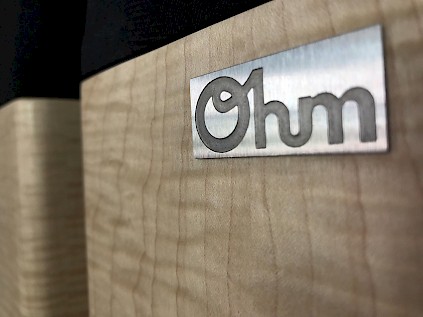
The Ohm Walsh use a speaker design that’s probably different from anything you’ve seen (or heard) before. About 80% of the Walsh is taken up by its rounded-square cabinet, which is supported about two inches above its base by standoffs. The upper portion of the Walsh are magnetically-placed speaker grilles which, when removed, reveal yet another set of speaker grilles, though the latter are not removable. Each speaker has a single set of cable binding posts on the rear (spades, banana plugs, and bare wire supported) and a downward-facing bass port hidden between the bottom of the cabinet and its base. Though the Walsh feel solid, they are clearly hand-built products; tiny imperfections like an occasional over-torqued screw or blob of glue will either be disappointing or add to the character of these speakers, depending on your perspective. Our review unites were finished light-tan maple veneer (we’re not sure of the core material of the cabinets); it’s a purely subjective choice, but we think that the darker woods look better with the black grilles and base of the Walsh.
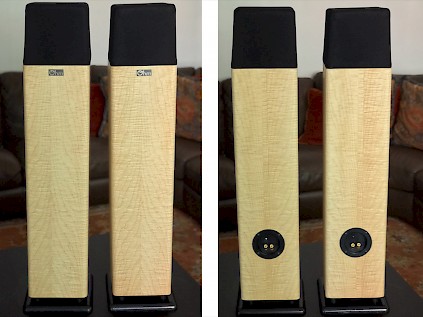
Ohm’s speakers are different from traditional speakers in more ways than just their curious appearance. Most loudspeakers use sets of front-facing drivers of varying sizes with internal crossovers to ensure that each driver only tries to reproduce the frequency range for which it’s best suited. Though it varies from speaker to speaker, traditional speakers often create a relatively narrow “sweet spot” in a room where the speakers sound best — visit any high-end speaker shop and note the single chair positioned carefully in the rear third of the room. Ohm’s speakers are different — they use the omnidirectional “Walsh” driver design. Each speaker is constructed with a downward-firing conical driver in a large rectangular cabinet and one super-tweeter aimed diagonally toward the center of the room. Sound waves travel down the sides of the conical driver, vibrating the edges in all directions; bass is amplified through the cabinet below. Though this is an unfairly simplified explanation of Ohm’s technology (more detail is available on their website), Ohm claims that this eliminates the “sweet spot” issue; the perceived volume of the sound naturally changes depending on the listener’s location relative to the speakers, enabling a 3D stereo image almost anywhere in the room.
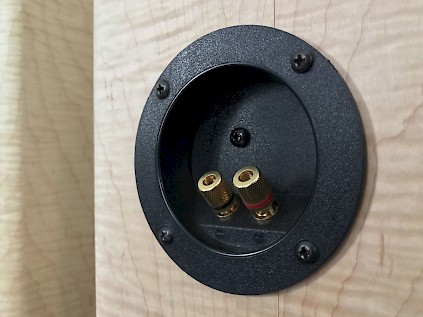
We tested the Walsh 1000 in a relatively small room that was far from what any speaker enthusiast would call “ideal” — no acoustic treatment, with other equipment placed around the room and not much space between the speakers and the wall. Ohm came by to set the speakers up and didn’t seem to have any problem with the room — according to Ohm, their design makes room treatments less important than they’d be with traditional speakers. Ohm recommends that they be positioned relatively near the wall and slightly toed in (angled towards the center of the room), though we experimented with angle and position to see how they’d react. The Walsh are rated at 6 ohms and 88 db sensitivity; Ohm recommends pairing the Walsh with an amplifier rated at between 30 and 150 watts; we tested the Walsh with a amplifiers of ranging price and power to see how the Walsh plays with different source gear.
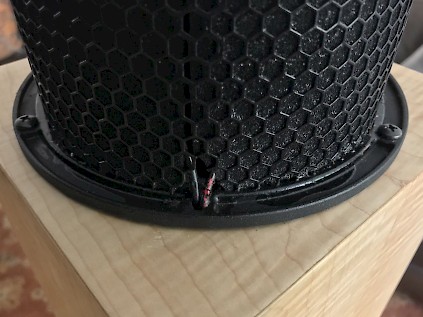
After many hours spent with the Walsh, one thing is for sure — the soundstage and “3D” imaging from the Walsh is excellent, and is far less picky about positioning than other speakers we’ve tried. Walking around the room didn’t seem to create an imbalance of sound at all. The stereo image ‘appears’ just above the speaker level, centered in the room. Voices and instruments sound detailed and natural, but large. In addition, the Walsh have no problem getting loud; as we turn up the volume, we only heard more detail as the speakers produced a kind of room-filling sound effect. Though the Walsh performed well with a budget power amplifier rated at about 70W per channel, they really sang when we switch to an amplifier rated at twice the power — everything sounded tighter and more controlled, particularly the low-end.

As a caution to prospective buyers — or, at least, a confession of our own mistake — it is possible to set up the Walsh speakers incorrectly. About halfway through our review process, we disconnected the speakers to take some photos, and put them back in what we thought was their original position. When we turned them on, however, we noticed a disturbing lack of midrange — had we broken them? Were these terrible speakers? We contacted Ohm for technical help, and, as it turns out, we had swapped the left and right speakers, causing the tweeters to fire in the wrong direction. We’re used to speakers that are sold individually because they’re identical, but the Walsh are directional. In our defense, there are no outwardly visible left and right channel markings on the Walsh — you must remove the grilles to find the stickers. We swapped the left and right speakers, toed them in slightly, and instantly they sounded great again.
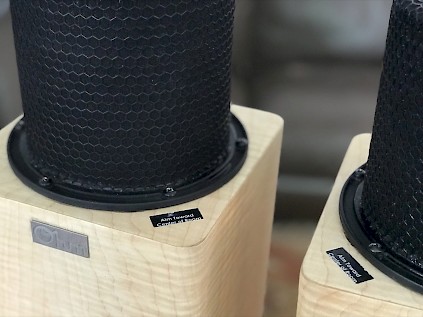
The Walsh have very respectable bass extension — down to 34 hz on the 1000 model — and properly amplified, they put out a clean, powerful low-end despite their relatively modest driver size. The Walsh’s woofers fire downwards into the cabinet, which end in a hidden downward-facing port suspended about two inches off the ground. The Walsh throws a ton of energy into the floor; without any isolation, the Walsh shook our apartment with palpable vibration through the floor at modest volumes. The potential downside of this — besides the slow torture of downstairs neighbors — is that the Walsh’s bass can completely overpower any detail in the mids and highs. We experimented with a few different materials (rubber feet, isolation pads, even yoga blocks) and found, generally, that putting something between the Walsh and the floor goes a long way to balance out their sound. We highly recommend using some dense isolation material under the Walsh, but ultimately the decision whether or not to allow your neighbors to sleep is your own.
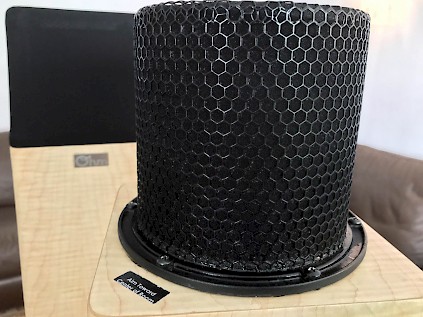
Complaining neighbors aside, we think the Ohm Walsh 1000 is an amazing speaker for small to mid-size rooms. It sounded excellent with everything we threw at it, from intimate acoustic recordings to multi-layered and synthetic electronic music. We liked them as home theater speakers as well, though they won’t replace a true surround system and a subwoofer would be needed for complete low-end coverage. One of the best things about Ohm’s line of Walsh speakers is that there’s no “good/better/best” — the different speakers are priced only according to room size, so there’s no need to worry that a bigger investment would get you better technology. One caveat, as we noted above, is that we think the Ohm performs better with an amplifier at the top end of Ohm’s recommendations for best sound. We had a great time with the Walsh 1000s — not only because they use non-conventional technology, but because they sound so good. Ohm offers a 120-day testing period for the Walsh, but you’ll have to wait a few weeks to have them built. If you’re an audiophile with limited space and reasonable neighbors, the Ohm Walsh are well worth the wait to experience.
